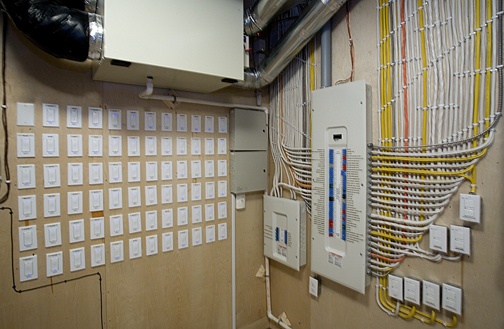Electricity serves as the primary power source that enables the operation of both domestic nighttime illumination and manufacturing equipment. The essential part of the energy process relies on electrical switchboards to operate. The unpretentious nature of these structures makes them indispensable for handling electrical power distribution with safety and operational efficiency. Observing the different switchboard types enables users to ensure safe power delivery to intended locations. Examining electrical switchboards can provide detailed knowledge of the essential yet underappreciated components of contemporary infrastructure to any person who holds professional proficiency in electrical work or commercial operations or shows interest in how power systems operate. The following section explores this vital concept at its core.
Types of Electrical Switchboards
The proper management of building electrical distribution relies on having electrical switchboards present. Various electrical switchboards serve specific requirements by meeting different specifications.
Power support systems receive electricity through main switchboards. Electricity distribution at the facility starts when panels receive direct power input from utility sources. Electrical switchboards provide design excellence for secure functioning and operation efficiency.
Building circuits of smaller sizes operate from distribution boards. The devices allow power entry while turning the input into multiple outgoing circuits and protect users through fuse-based or circuit breaker systems. Distribution boards serve both homes and commercial buildings across the world.
Distribution boards and substations use distinct features to maximize performance under specific operational requirements. The knowledge about diverse electrical equipment enables you to make suitable electrical system choices.
Main Switchboards
Commercial and industrial premises use main switchboards as their fundamental electrical distribution centers. Utility company power flows through these boards before they transmit electricity to multiple facility circuits.
The main boards are vital elements for both safe and efficient electric power management. These devices work with breakers that safeguard facilities from both overloads and short circuits.
The size of main switchboards depends on building requirements because they exist inside metal cabinets. The well-planned layout of main switchboards serves to deliver sufficient power to every business area in a manner that respects safety standards.
Good maintenance practices help extend both lifetime and operational efficiency of systems. Prior to expensive repair work or operational stoppages regular inspections help find potential problems. Switchboard technicians benefit from easier troubleshooting because proper labels are installed inside the switchboard.
Distribution Boards
The effective repair of electrical sub boards requires appropriate tools for the job. A multimeter stands as an essential tool which enables effective reading of voltage current and resistance values.
A screwdriver set follows the multimeter as the second essential tool. You will require separate Phillips and flathead screwdrivers to handle the safe unlocking of different board components. The process of removing insulation from wires without damaging their structure is possible through the use of wire strippers.
Plenty of tasks need plier help because they provide effective wire bending and gripping support. An oscilloscope becomes highly beneficial for advanced troubleshooting because it helps analyze waveforms.
Your toolkit requires safety equipment alongside other instruments. The combination of insulated gloves protects hands against electric shock while safety goggles protect eye safety during electrical repairs because they shield eyes from flying debris and sparks.
The multiple tools you use together make it possible to handle problems effectively while maintaining safety at your electrical sub board installation site.
Key Components of Electrical Switchboards
A comprehensive switchboard contains essential elements which provide secure operations for power transmission. Someone who operates with electrical systems needs to learn about their principal sections entirely.
The circuit breaker function stands as the primary element. A circuit breaker serves as protection against overloads while short circuits trigger its automatic power supply cut when they occur.
Busbars are another critical element. The conductive bars spread power across multiple circuit networks inside the switchboard so numerous loads can efficiently obtain energy from one centralized power supply.
Necessary functionality depends on metering devices and their role in switching operations. These devices both measure power usage and sense unexpected abnormalities to keep equipment at its peak operational capacity.
The enclosure guards the inside mechanisms from all external conditions while preserving security protocols. All these elements establish a dependable infrastructure for electrical control across domestic and business environments.
Understanding Three-Phase Power and its Role in Switchboards
Switchboards depend fundamentally on the three-phase power system for their operation. Three alternating current waves form this system through proper angular displacement of 120 degrees. Such a power distribution system enables efficient energy management that best serves commercial and industrial environments.
Three-phase power operates effectively because it provides steady power that shows less power fluctuations than single-phase power systems. The synchronized operation of three alternating currents creates more fluid performance of heavy machinery and equipment. The switchboards designed for three-phase operation can manage large power loads without thermal issues as they distribute power efficiently.
Organizations need to follow specific guidelines when building three-phase systems within switchboards. For proper power distribution the wiring needs analysis as well as proper selection of circuit breakers which handle complex electrical loads better.
Electric switchboards attain considerable enhancement in performance and reliability when operators understand how to integrate three-phase power systems. The knowledge of this system relationship enables businesses to maximize their energy efficiency by preventing overloads or unbalanced conditions in the network.
Acquiring this information will help you better understand how electrical switchboards perform their role in modern electrical infrastructure management.




